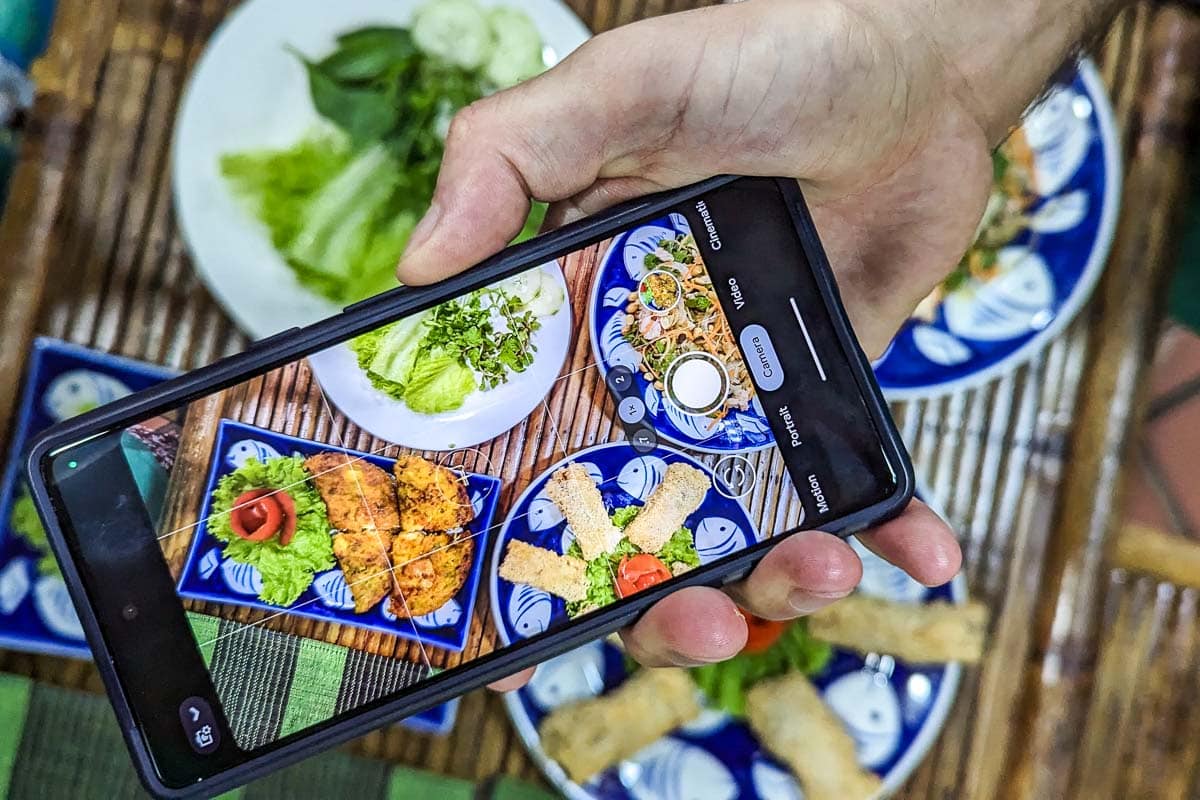From street food snacks and fragrant noodle dishes to the famous bánh mì sandwich, here’s what to expect on a Hoi An food tour.
Are you someone who travels for food? Good – me too! Some of my happiest travel memories have involved meals!
Tucking into a tasty Thai curry in Koh Lanta just after we got engaged, cooking up a feast in Mauritius, shopping for unique ingredients in San Sebastian and then learning how to create some amazing dishes. What great times! It’s hardly surprising that one of the biggest reasons for planning a trip to Vietnam was so I could finally taste some of my favourite foods in their country of origin.
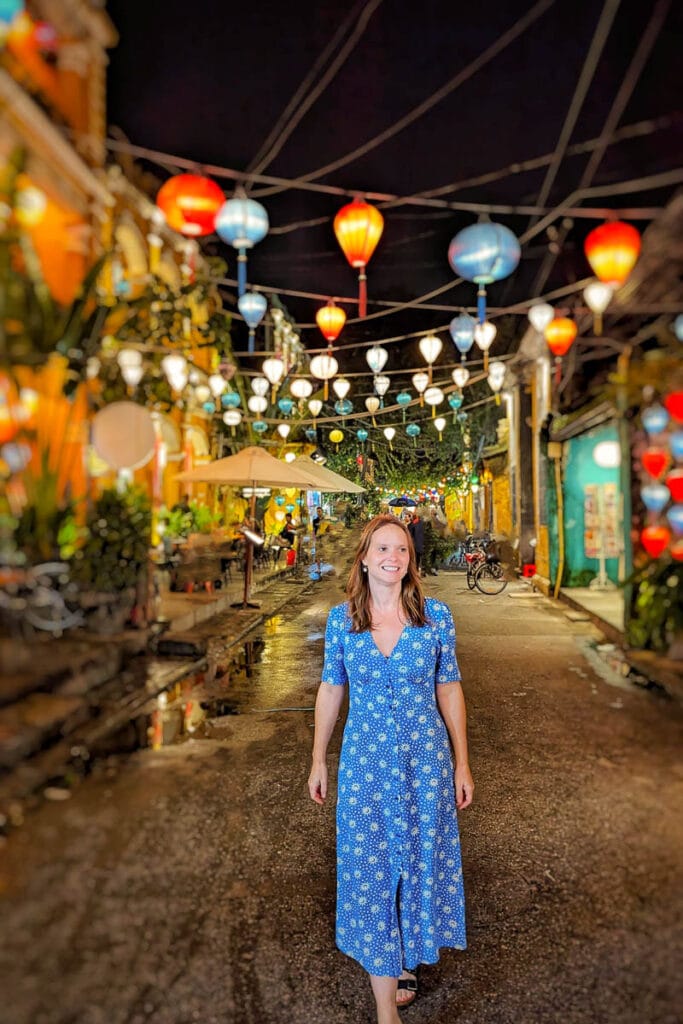
I’ve been to a few Vietnamese restaurants in London and always loved the zingy, fresh flavours. Some of my favourite dishes include light vermicelli noodles, smothered in dressings of chilli and lime, hearty bowls of beef pho with tasty broths enriched with Asian spices, and fresh spring rolls with their translucent wrappers encasing prawns, vegetables and herbs.
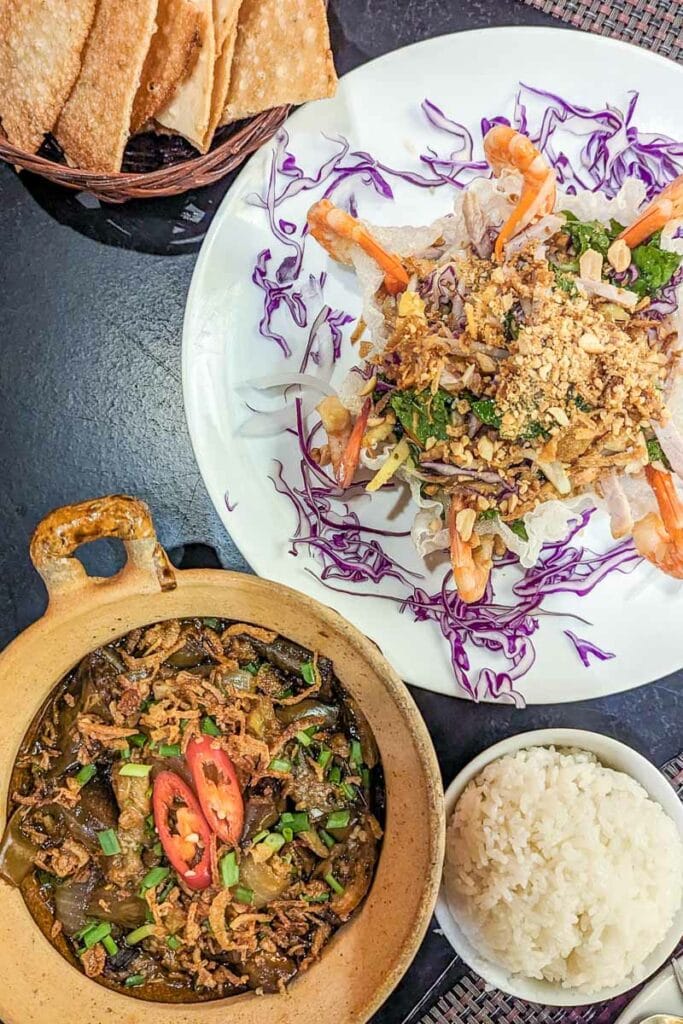
We definitely wanted to go on street food tour in Vietnam. Once we’d planned our 3-week itinerary, we felt that Hoi An would be the best destination for it. This pretty city is in the centre of Vietnam, and offers a fusion of the flavours from the north and south. With numerous restaurants, street food stalls and a vibrant market, it’s the perfect place to get to grips with Vietnam’s food scene and culture.

We booked the Hoi An: Unique Street Food Tour via GetYourGuide – always my preferred platform when I’m travelling. I’ve always had great experiences on their tours and found them to be very professionally run. The price seemed reasonable and with a start time of 3.30pm, it fit perfectly with our 8-month-old son’s nap schedule! Yep, this was a tour for us as a couple, but we were fairly sure our baby would be sampling a few delicacies along the route too!
The culinary tour would involve seven food stops across three hours. Some stops would be small street food stalls at the side of the road, while others would be dining experiences in restaurants. We had a great time so I wanted to share a little about what to expect if you’re considering booking a Hoi An street food tour.
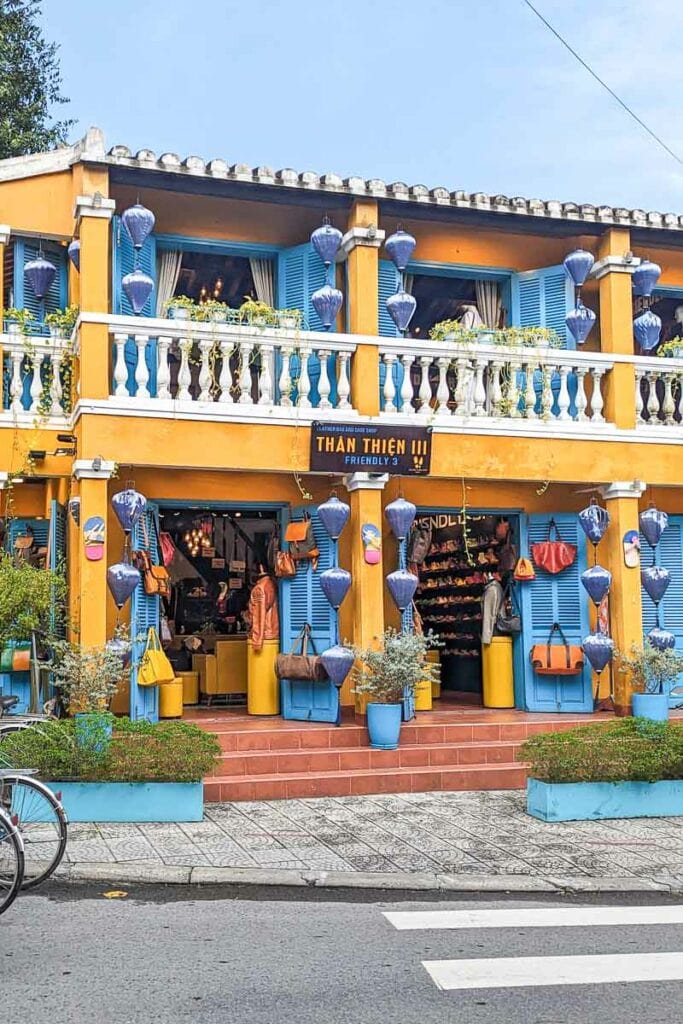
A Street Food Tour Of Hoi An
We met our guide Hahn at Godiva, a trendy café towards the east of Hoi An’s centre. It was a comfortable place to relax into the tour, find out more about what the next three hours would entail and meet our fellow tour mates! There were 4 of us in total (5 if you include our baby!) One lady from Chicago, a guy from the south of England and us two Londoners. After some chit chat, hearing about everyone’s trips around Vietnam, our guide started the tour.
Stop 1 – Vietnamese Coffee
Vietnam has a great reputation for coffee. Traditionally it’s brewed using a drip method. Unless you order your coffee black, you’ll find it comes with a thick layer of sweet condensed milk at the bottom. The coffee is usually very strong and quite bitter, but when mixed with the condensed milk it balances and has a sweet, caramelly hit.


Condensed milk has been added to Vietnamese coffee since the 1850s. Back then it was hard to get hold of fresh milk, so this long-life alternative became popular.
One of my favourite things about Vietnam’s coffee scene is that there are so many different types to try. The most popular variations are coconut coffee, sea salt coffee and egg coffee. They might sound odd, but all were really delicious! I’ll admit they all felt more like desserts, than the warming caffeine hit we’re used to having when we wake up!
Stop 2 – Vietnamese street food snacks
From the trendy café, we started walking through the streets of Hoi An. There were so many little snapshots of local life all around. Kids playing in school playgrounds, street vendors selling big bunches of flowers, office workers on scooters zooming around the city. We paused at a little street food stall. As a tourist, I can’t imagine I’d ever have stopped here as it wasn’t very clear what the lady was selling. It’s for moments like this that I love street food tours! You get to try dishes you’ve never heard of and wouldn’t know how to order.
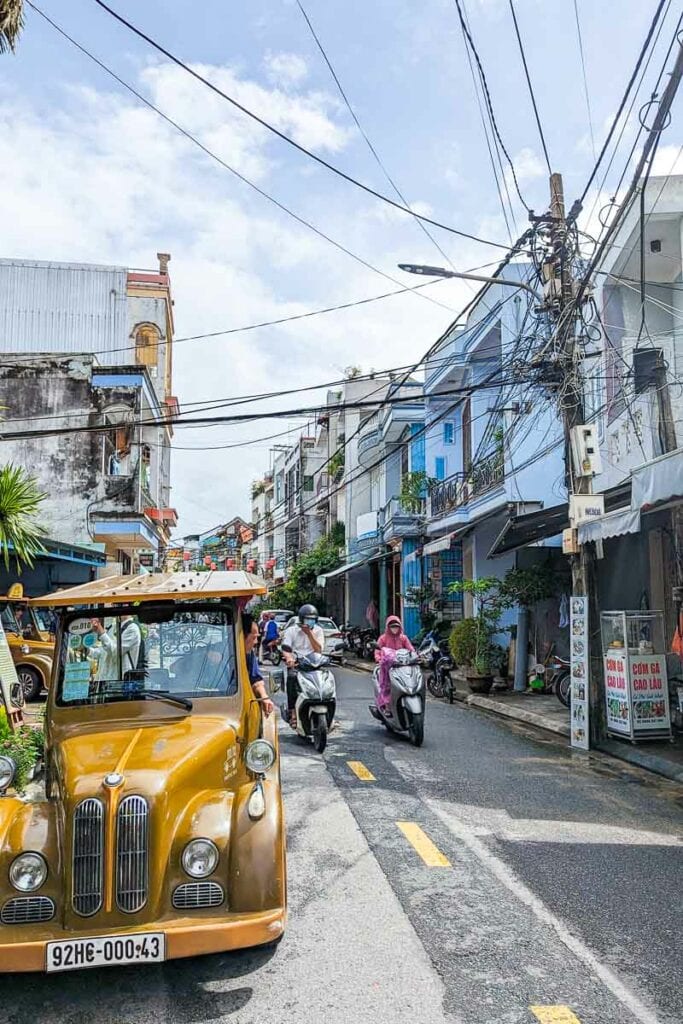
We tried a selection of dumplings: bánh loc, bánh ít and nem-cha. Bánh loc are steamed tapioca dumplings filled with shrimp. Bánh ít are sticky rice cakes with a mushroom filling, steamed in banana leaves. We also tried some dumplings with a mung bean filling. They were all smothered in a tasty fish sauce dressing, and made a very flavoursome snack.
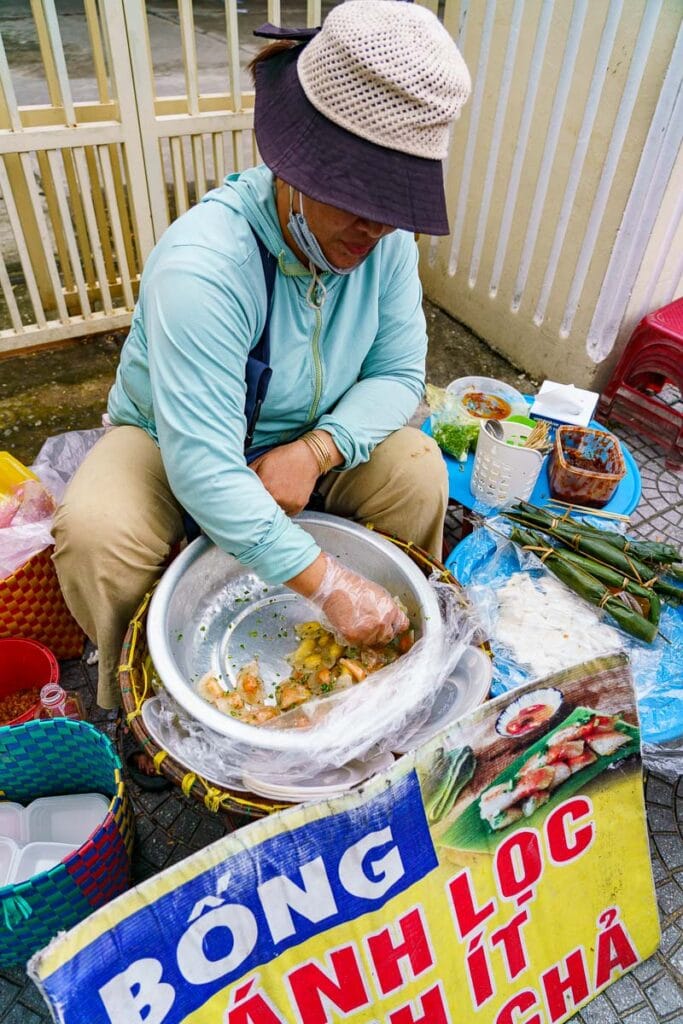
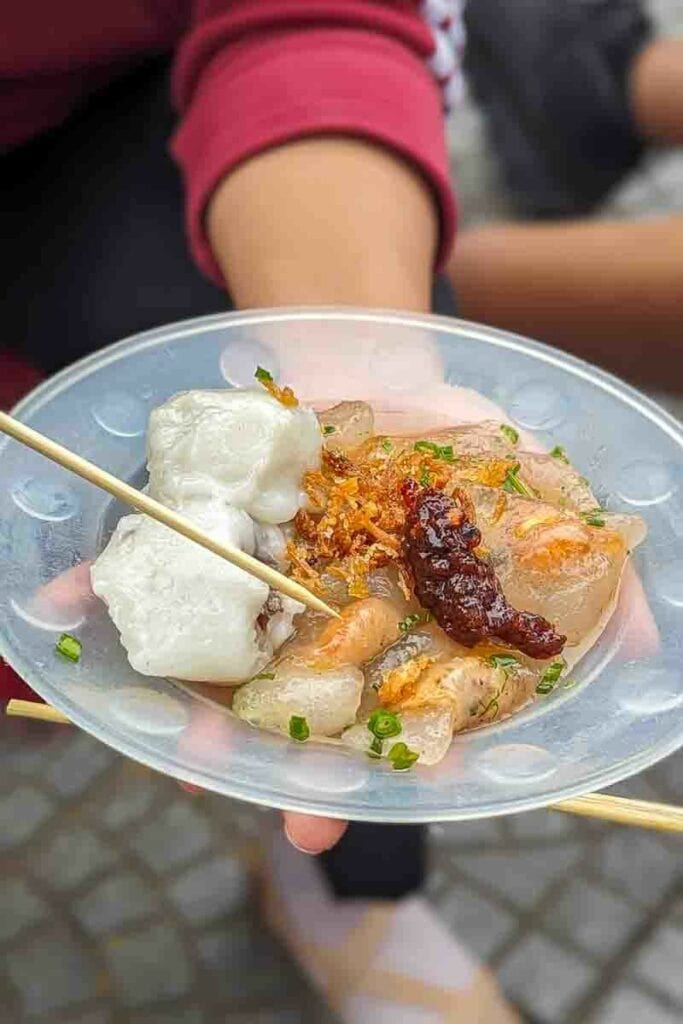
Our guide explained that these street foods are traditionally eaten in the afternoon, and the vendor running this stall would set up from 2-5pm. Locals came and went while we were there, having a quick plate of dumplings on the street, then continuing their day. I enjoyed the insight into local life – how people really live in the vibrant city of Hoi An.
Stop 3 – Mì Quảng and Cao Lâu
Our third stop was at a casual eatery. At the front was a little cooker with big vats of broth and a few fresh ingredients. Again, not probably somewhere you’d feel confident venturing as a tourist, as you wouldn’t be totally sure what to order.

Here we tried two of Hoi An’s most famous dishes. Mì Quảng is a noodle dish made with flat yellow rice noodles. The noodles are covered in a small amount of tasty broth (not a big bowl like pho). They were then topped with slices of pork, bean sprouts, greens and crackers. The broth was aromatic and warming – a really delicious bowl! We were invited to add lime and chilli from dishes on the table too.
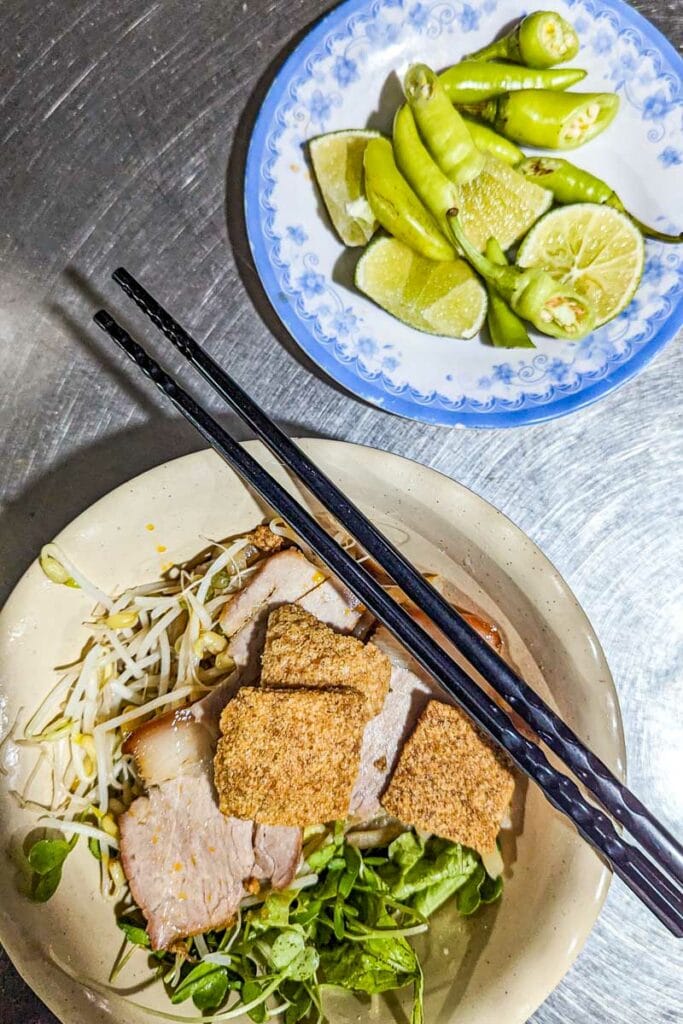
Cao Lâu is another local noodle dish. Similar to Mì Quảng, this dish sits in a broth and is topped with pork (usually BBQ) and herbs. This dish can only be produced locally as the water has to be drawn from a well nearby and then mixed with ashes from local trees. This unique process makes the noodles yellow and gives them a smoky flavour and chewy texture.

If you’re wondering about the price of cheap eats in Hoi An, a bowl of Cao Lâu was just 20,000 VND (65p or $0.85!) If only we felt more confident eating at places like this more regularly, we’d save a lot of money on our travels!
These two dishes were great examples of the Vietnamese flavours which go from salty, to spicy, to bitter, sweet, crispy and fresh. A real taste sensation!
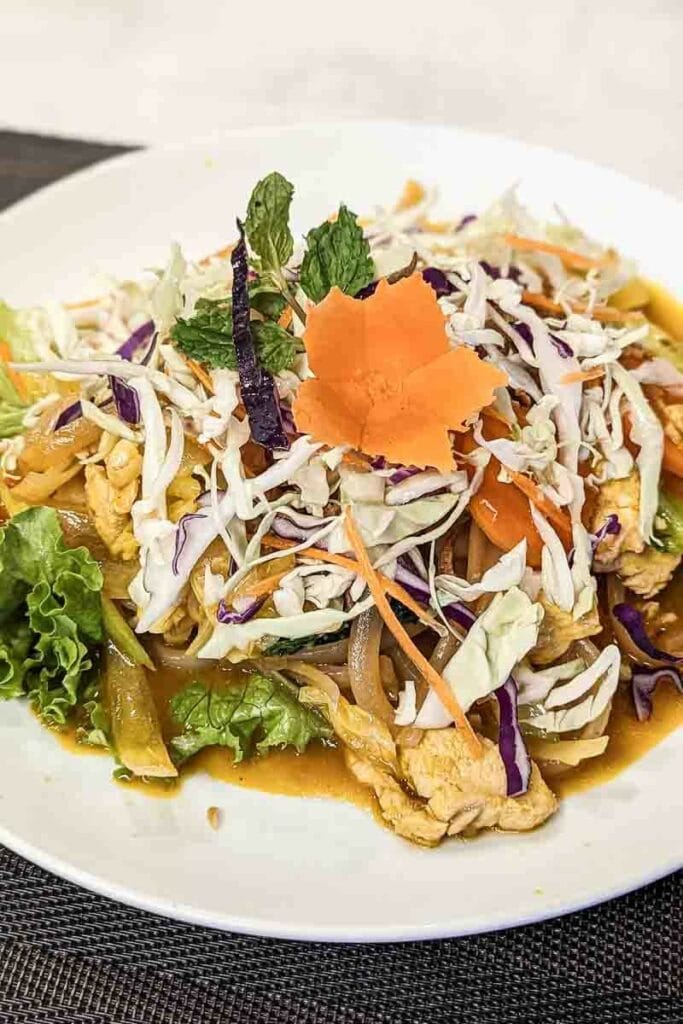
Stop 4 – Com Ga
Our next stop (and wow were we starting to get full already!) was to another street food seller on the side of one of Hoi An’s busiest streets. This lady specialised in making com ga, a.k.a. Vietnamese chicken rice.

The base is a fluffy turmeric rice which has been cooked in chicken stock. This is then topped with a salad of shredded chicken, onion, carrot, papaya, Vietnamese coriander and a zingy dressing. It was served with a rich bowl of chicken soup and optional chilli sauce.
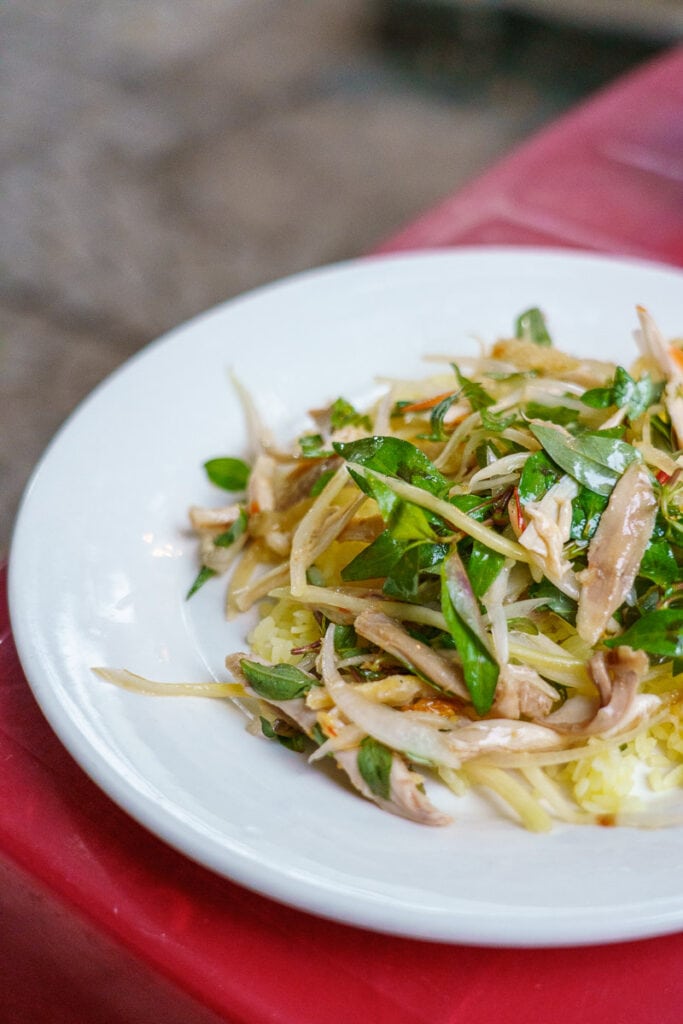
This simple dish is filling and tasty. I loved the vibrant flavours of the toppings, especially the Vietnamese coriander. It was also fun soaking up the buzz of the city, sitting on tiny stools at the side of the road, watching people go about their days.

Stop 5 – Bánh Mì
You can’t visit Vietnam and not try a bánh mì. We’d already been in the country a week, and so far had eaten one of these traditional Vietnamese sandwiches, and been very underwhelmed. I hoped trying one on this Hoi An street food tour would be a better experience.
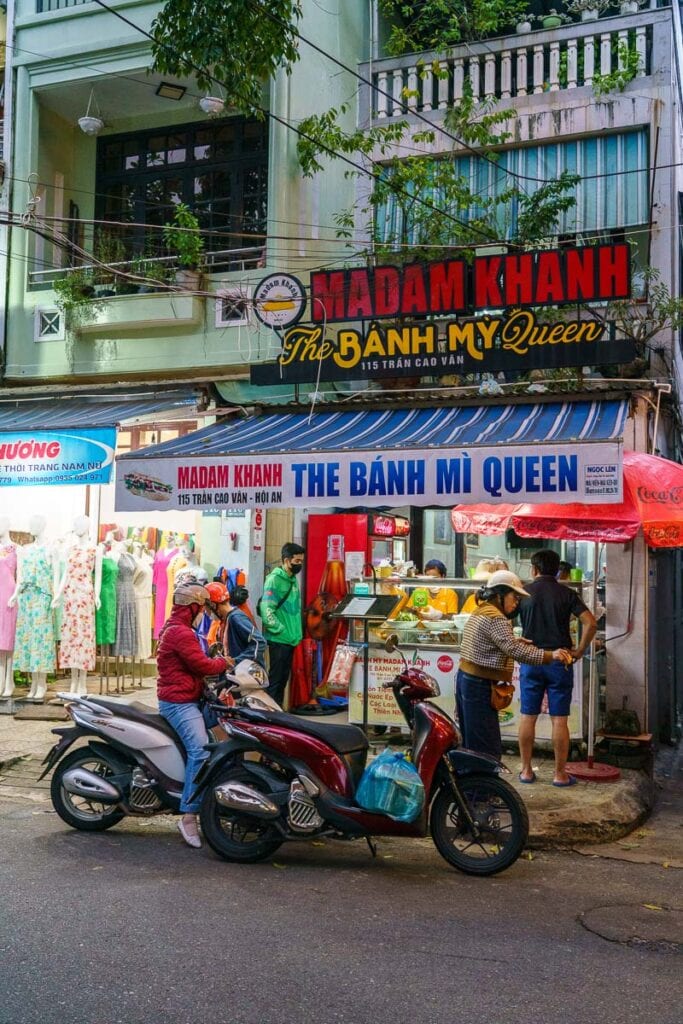
We went to Bánh Mì Queen – a really popular spot with options to eat in or take away. A typical bánh mì is a crusty baguette filled with pate, ham, pickled vegetables, mayonnaise, coriander, chilli and a bit of sauce that tastes a bit like a rich gravy.
Our bánh mìs cost the equivalent of 30p! I couldn’t quite believe you could get such an enormous sandwich in a city like Hoi An, for so little money. We sat upstairs in the restaurant area enjoying the buzz of locals and tourists all under one roof.

As for the sandwich? It had lots of flavour and was a lot nicer than the ones we’d tried before. I’m not a huge fan of the pate or ham used (feels a bit like ‘mystery meat’!) so I’m not sure I’d include a banh mi in my top 5 Vietnamese dishes. It is however a very cheap eat if you’re on a budget, and one sandwich will fill you up for hours.
Stop 6 – Bún Thịt Nướng
I couldn’t quite believe that we still had two stops to go! We were getting so full by this point that I had to palm off half my bahn mi to my partner in order to save some space for the final dishes. I’d already tried bún thịt nướng at a restaurant a few days before, and absolutely fallen in love with the dish.

It’s a vermicelli rice noodle salad, topped with pork, fresh herbs, shredded vegetables and peanuts. It’s smothered in a zingy dressing, with lots of lime and salty fish sauce. There was the option to add some bits from the table too, including chilli and a squeeze of kumquat! I loved learning more about some of the rarer ingredients. There was a strong flavour in this dish and it turned out to be perilla – known as the rice paddy herb, or perhaps more commonly as shiso.
How much for a bowl of bún thịt nướng in Hoi An? 30,000 VND, that’s around £1 or just over $1! Another bargain – you just need to know where to go and what to ask for.
Stop 7 – Bánh Xèo
Our Hoi An food tour ended at Quán Cao lầu Bá Lễ, a popular restaurant in the old town. Here, with rather full tummies, we tucked into a sharing plate of bánh xèo. These Vietnamese pancakes are bright yellow, made from rice flour and turmeric. They’re folded over and fried. Tucked inside you’ll usually find prawns and beansprouts. We’d actually had these already elsewhere and didn’t know the correct way to eat them, so it was great to have a guide to explain.

First you take a piece of rice paper, then you break off a bit of the pancake, add some of the fresh greens (usually cucumber, lettuce and herbs), then you roll it all up, dip it in fish sauce or peanut sauce and eat it! They’re a real Vietnamese delicacy, and definitely worth trying while you’re visiting.

As a parting gift, our guide gave us some fresh Vietnamese coconut pastries to take home for dessert. We were so full, we didn’t find space until the next day.
As our Hoi An Street food tour drew to a close, we thanked our enthusiastic guide for all her stories and tips, and said farewell to our fellow guests. This tour was a great way to learn more about Vietnamese cuisine and to try dishes we might not have had the confidence to order. With another week in the country, it also gave us lots of ideas for dishes to try again before we finished our trip!
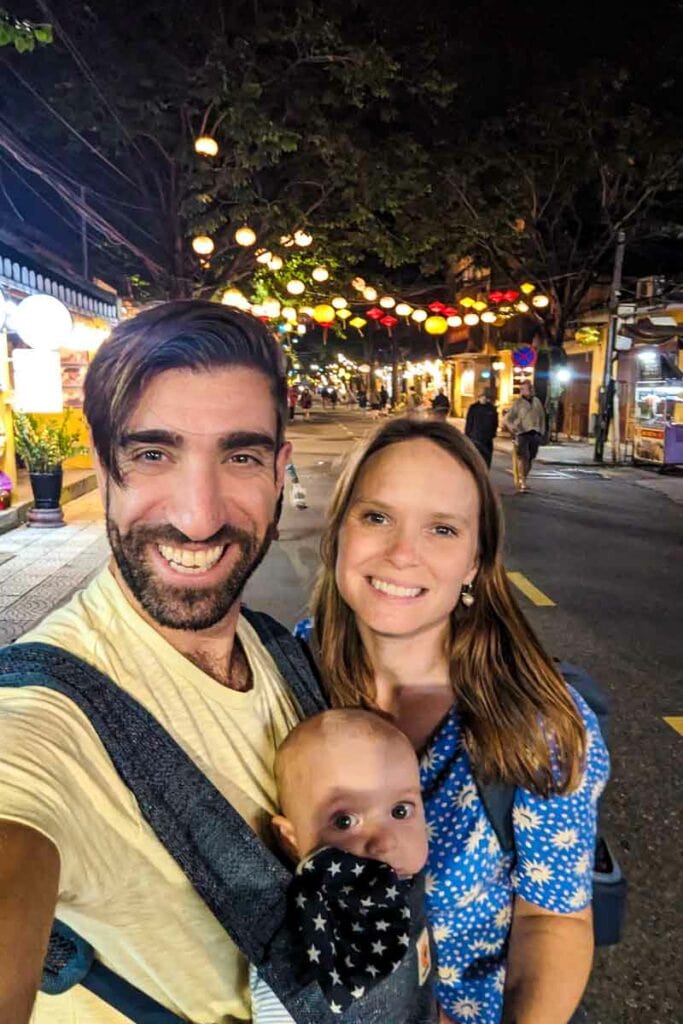
I’d definitely recommend this Hoi An street food tour. If you’re keen to follow in our footsteps, you can book the same tour via GetYourGuide here. Also, if you are a total foodie, I’d also recommend this Vietnamese cooking class. It took place in the Coconut Village area just outside of Hoi An and we learned how to cook so many delicious dishes. It’s one of the best cooking classes we’ve done on our travels.
If you’d like to look at other Hoi An food street food tours or cooking experiences, here are a few others that come highly recommended.
6 Quick Tips For going on a street food tour in Hoi An
- If you have any dietary requirements, definitely contact the guide ahead of your tour to let them know. Fish sauce is a staple of Vietnamese cuisine, so you may struggle to adhere to a vegetarian or vegan diet.
- Wear comfortable shoes. There’s a lot of walking involved between stops. For more advice on what to pack, I’d recommend reading my guide to what to wear in Vietnam. I’ve included tips for clothes, accessories and other items you might not have thought about.
- Arrive hungry! The portions are generous and you’ll be eating a lot throughout the 3-hour tour. You’re unlikely to need dinner afterwards.
- Wear sunscreen. You’ll be out in the sun a little on this tour, especially as some of the street food stops are out in the open.
- If you have mobility issues, this probably isn’t the tour for you. As mentioned, you cover some distance on this tour, so if you struggle to walk far, you’d probably find it too challenging (and the pace too fast).
- Be open minded! You probably won’t love every morsel that you eat, but this tour is a great way to learn about Vietnamese cuisine and gain a greater understanding of the culture.
Looking for other content about Vietnam? Don’t miss these posts:
- The Ultimate 3-Week Vietnam Itinerary
- 10 Tips For Visiting Vietnam With A Baby
- Visiting Halong Bay With Kids: The Best Family Cruise Experience
- What To Wear In Vietnam For Women And Men: Vietnam Packing Guide
Enjoyed this post? Pin it for later…



